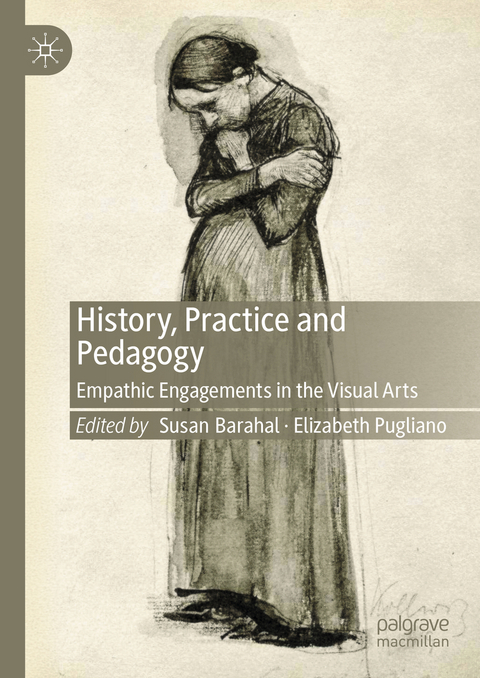
History, Practice and Pedagogy
Springer International Publishing (Verlag)
978-3-031-70254-9 (ISBN)
This edited volume explores the historical, practical and pedagogical possibilities for expressing and cultivating empathy through works of art. While aspects of what we today recognize as empathy has nestled in the artistic experiences and philosophies of all ages, the subjective and elusive nature of empathic responses has often resulted in the relegation of empathy to the margins of art historical inquiry. Moving into the second quarter of the twenty-first century, amidst global health crises, civic unrest, political turmoil, and persistent social inequities and injustices, this capacity to feel with and as someone or something outside of ourselves is more critical than ever. Probing the very notion of empathy, contributions address themes ranging from environmental and social justice to identity and inclusion to transdisciplinary pedagogies and practices, each with a critical eye to how works of art not only appeal to empathic sensibilities, but might play an active role in developing capacities for empathy in viewers.
Susan Barahal is a Senior Lecturer at Tufts University, USA where she teaches courses on art education. Her research interests include how art facilitates and informs learning and understanding across the disciplines and content areas. Susan's recent research explores the empathic responses that art objects evoke in viewers. She is a practicing artist and a juried member of the New England Sculptors Association.
Elizabeth Pugliano is Senior Instructor of art history at the University of Colorado Denver. Her work balances art historical research on violence, combat, gender, audience, reception and cognition in medieval art with pedagogical inquiries into issues encountered in the art history classroom and innovation in teaching practice.
Chapter 1. Introduction.- Chapter 2. Gotthold Ephraim Lessing on Laocoön: Empathy, Motor Imagery, and Predictive Processing.- Chapter 3. Translations of Pain: Ferdinand Hodler's Cancer Paintings of Valentine Godé-Darel.- Chapter 4. Paint and Pain: Gustav Adolf Mossa's Psychological Self-Portrait, Misogynist Self-Empathy, and Bloody Decadent Creativity.- Chapter 5. Objective Non-Empathy in Late Nineteenth-Century France.- Chapter 6. Abstracting Empathy: Wassily Kandinsky and His Artistic Interpretations of Theories in Visual Perception.- Chapter 7. Engaging Feeling: The Subject of Landscape in the Twenty-First Century.- Chapter 8. Thinking Empathy in Biennials and Art History Again.- Chapter 9. The Empathic Space of Art: Video Games and Virtual Reality as Tools in Socially Engaged Art Practice.- Chapter 10. Empathy in Roman Commemorative Art. Chapter 11. "She-the great agitator": Käthe Kollwitz and the Limits of Empathetic Spectatorship in Weimar Germany.- Chapter 12. Empathic Engagements with Death and Loss in the Work of Diane Victor.- Chapter 13. Empathy Rather than Ageism: A Daughter's Portrayal of Her Elderly Holocaust Survivor Mother.- Chapter 14. The Empathic Resonances of Village of Women (2019): On Cinematic Expansion Through Retreat.- Chapter 15. Feeling Into and Feeling With: Art Practice and Empathic Attention.- Chapter 16. Art as Empathetic Connection: Ways to Heal the Brain and Soul from Trauma.- Chapter 17. Visual Art and Empathy: A Fusion of the Intellectual and Emotional.- Chapter 18. Exploring Empathic Engagements: Resources for Educators and Students.
| Erscheinungsdatum | 23.11.2024 |
|---|---|
| Zusatzinfo | XXII, 386 p. 57 illus., 41 illus. in color. |
| Verlagsort | Cham |
| Sprache | englisch |
| Maße | 148 x 210 mm |
| Themenwelt | Sozialwissenschaften ► Pädagogik ► Schulpädagogik / Grundschule |
| Schlagworte | Art education • Art History • artistic empathy • contemporary Art • Embodiment • Social Justice • Visual Literacy |
| ISBN-10 | 3-031-70254-9 / 3031702549 |
| ISBN-13 | 978-3-031-70254-9 / 9783031702549 |
| Zustand | Neuware |
| Informationen gemäß Produktsicherheitsverordnung (GPSR) | |
| Haben Sie eine Frage zum Produkt? |
aus dem Bereich


